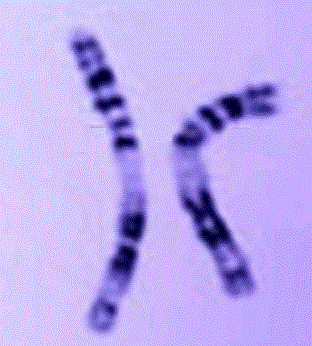| What the Human Genome Project and
others did was to map genes. For example, |
| for most people the INS gene is found
on chromosome 11 in the region known as |
|
p15.5 - sometimes the location is described as between molecular
base pairs |
|
2,159,779 to 2,161,209. Chromosome 11 (untangled version shown
below) has about |
 |
| 135 million total nucleotides (about
4% of the total for a human). Different surveys |
|
have tallied between 1224 and 1327 protein coding genes on
human chromosome 11 |
| (out of a total of about 24,000
total for humans); 840 pseudo-genes
(perhaps as many |
|
as 33,000 total - a very heavily disputed
area); and between 270 (!) and 1060 (!!) |
|
genes that do not code for proteins. A challenge is
that many of the third |
| group are genes that regulate other
genes.
Note that about 90% of our DNA does |
|
NOT have a known function. A further challenge is that not
everyone agrees on what
|
| the name of a gene should be. The
synonyms for INS include IDDM2, ILPR, IRDN |
| and MODY10. |
| Insulin is a fairly conservative
protein - most changes in it will cause diabetes. The |
| changes can include [1] a single nucleotide change
that results in a different amino |
|
acid; [2] a misplaced start or stop triplet; [3]
a repetition of a triplet (so CAGCAG |
|
instead of CAG - note that repeats can extend into the
hundreds); [4] a deletion - |
|
perhaps of a triplet but sometimes of a region or even
a whole chromosome; |
|
[5] a trans-location such that the part of chromosome
11 containing the INS gene |
|
winds up attached to some other chromosome; [6] the
part of chromosome 11
|
|
containing the INS gene is moved elsewhere in
chromosome 11; [7] a section of some |
| chromosome attaches to chromosome 11;
[8] an extra copy of part or all of a |
| chromosome. This last is usually know
as a trisomy. The most common trisomy |
| involves chromosome 21 and is known
as the Down Syndrome spectrum. There |
| is a similar spectrum of effects for
chromosome 11 trisomies - they are generally |
| as devastating as Down syndrome. [10]
To confuse matters even further there are |
| epigenetic effects - methylization
and histone modification are two of the most |
| common - where someone might have
normal looking DNA but some genes |
| have been de-activated. |
| In a teaching situation it does not
matter to us whether a flaw in INS or any other |
| gene was inherited from the father,
the mother or was de novo (different from either |
| parent). The student is what the
student is. However, it is likely of interest to parents |
| if they have had or might have other
children. |
